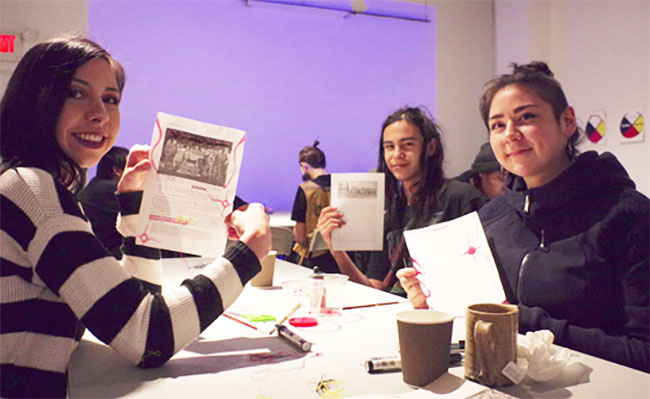Threading what reconciliation means to them

By Rick Garrick
THUNDER BAY – The creation of artwork from the printed pages of the Final Report of the Truth and Reconciliation Commission was featured at Neechee Studio’s Hand Stitching and Embroidery workshop.
“We kind of deconstructed the Truth and Reconciliation Commission summary,” says Sage Laliberte, a Chippewas of the Thames citizen who helped assist Indigenous artist Betty Carpick during the Jan. 13 workshop. “People could pick different pages from each chapter and kind of start threading through and highlighting on different words of what reconciliation means to them or what stuck out or resonated with them.”
Laliberte says the participants used a variety of techniques to create their artwork from the pages of the report.
“A lot of people added a lot of different colours — we used red, black, white and yellow, so the different colours from the medicine wheel,” Laliberte says. “They just highlighted different pictures that they liked and different words that stuck out to them.”
Laliberte adds that some of the participants created designs with Woodland-style power lines on their artwork.
“(They were) just putting that in random spots on the pages,” Laliberte says. “So that was kind of cool.”
Shelby Gagnon, a fourth-year Lakehead University art student who also helped assist Carpick with the workshop, says the participants explored the Truth and Reconciliation Commission report through a healing process using colours from the medicine wheel.
“A lot of people enjoyed using the ink and creating their different aspects of how they view it,” Gagnon says. “I see a lot of power lines connecting different words to each other. A lot of people used the colour yellow just to have that aspect of happiness and forgiveness.”
The Hand Stitching and Embroidery workshop was conceived by Carpick, a Cree artist from northern Manitoba, to create awareness and education around the Truth and Reconciliation Commission report.
“I thought by dismantling and reassembling the (report), we could have people take a look at it by examining the individual pages and stitching on them and using ink,” Carpick says. “So it was kind of a more subtle way of learning.”
Carpick says there was a “great” response from the participants at the workshop, which was held at Definitely Superior Art Gallery in Thunder Bay.
“People are reading the pages, they are examining these photographs,” Carpick says. “I think some of them may have never even picked up this (report) if it had not been for this project. It is an important document, and I think with the present political climate, we all have to work at being as kind and generous and compassionate to each other as we can and learn from the past.”
Carpick plans to reassemble the report after the participants complete their artwork and display it at Definitely Superior Art Gallery’s Urban Infill Art in the Core multi-sensory art and live performance presentation, which is scheduled for Jan. 27-April 7 at the Waterfront District in Thunder Bay.
“We are going to take images of each page for a slideshow and we’ll show the assembled book,” Carpick says. “So I hope we get some attention for it, because it is a great way to involve the community in looking at an important document.”
The Urban Infill presentation will feature 15 projects, 400 artists and 20 venues this year. Last year it was recognized with the Cultural Event of the Year 2017 award by the City of Thunder Bay Arts and Culture Awards and Best Exhibition 2017 in The Walleye Magazine, Best of Thunder Bay Survey.


